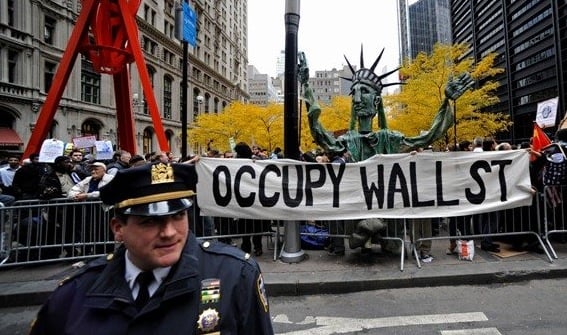Banks are hurriedly bracing for widespread demonstrations, disruptions and disturbances on May 1, as the Occupy Wall Street movement kicks off a new season of rabble-rousing. Says one security expert: It's like elks versus wolves.
The world's biggest banks are working with one another and police to gather intelligence as protesters try to rejuvenate the Occupy Wall Street movement with May demonstrations, industry security consultants said.
Among 99 protest targets in midtown Manhattan on May 1 are JPMorgan Chase & Co. (JPM) and Bank of America Corp. (BAC) offices, said Marisa Holmes, a member of Occupy's May Day planning committee. Events are scheduled for more than 115 cities, including an effort to shut down the Golden Gate Bridge in San Francisco, where Wells Fargo & Co. (WFC) investors relied on police to get past protests at their annual meeting this week.
“Our goal is to kick off the spring offensive and go directly to where the financial elite play and plan,” she said.
After evictions and arrests from Manhattan's Zuccotti Park to London that began last year, the movement against income inequality and corporate abuse will regain strength, said Brian McNary, director of global risk at Pinkerton Consulting & Investigations, a subsidiary of Sweden's Securitas AB. (SECUB) He works with international financial firms to “identify, map and track” protesters across social media and at their assemblies, he said. The companies gather data “carefully and methodically” to prevent business disruptions.
Banks are preparing for Occupy demonstrations at the North Atlantic Treaty Organization's Chicago summit on May 20 and 21 by sharing information from video surveillance, robots and officers in buildings, giving “a real-time, 360-degree” view, said McNary, who works on the project.
Elk Versus Wolves
Banks cooperating on surveillance are like elk fending off wolves in Yellowstone National Park, he said. While other animals try in vain to sprint away alone, elk survive attacks by forming a ring together, he said.
Planning for May 1 in New York began in January in a fourth-floor workspace at 16 Beaver St., about two blocks from Wall Street, according to Holmes. The date serves as an international labor day, commemorating a deadly 1886 clash between police and workers in Chicago's Haymarket Square.
The midtown demonstrations will take place from 8 a.m. to 2 p.m., followed by a march from Bryant Park to Union Square and a 4 p.m. rally there, according to an online schedule. Protesters, including labor unions and community groups, have a permit to march from Union Square to lower Manhattan, according to police. Goldman Sachs Group Inc. (GS)'s headquarters is among financial- district picketing options, Holmes said.
Atrium Closed
Banks are bracing. Deutsche Bank AG (DBK) is closing the public atrium of its U.S. headquarters at 60 Wall St., which protesters have used for meetings, Holmes said. Duncan King, a bank spokesman, declined to comment.
New York police can handle picketers, said Paul Browne, a spokesman. “We're experienced at accommodating lawful protests and responding appropriately to anyone who engages in unlawful activity,” he said. “We're prepared to do both next month.”
Banks have a history of coordinating security with city authorities. At a 2009 U.S. Senate hearing, Police Commissioner Raymond Kelly described a partnership with financial-district firms that gives his department “access to hundreds of private- security cameras.” Footage is monitored in a downtown Manhattan center, he said. A 2005 letter Kelly wrote to Edward Forst, then chief administrative officer at Goldman Sachs, shows it was among firms getting space in the facility.
‘Fire' Rekindling
Starting in 2010, JPMorgan gave the New York City Police Foundation the largest donation in the group's history, the bank's website shows. The gift, valued at $4.6 million, included 1,000 patrol car laptops. “These officers put their lives on the line every day to keep us safe,” Chief Executive Officer Jamie Dimon, 56, said in a statement on the website.
New York companies have provided services and equipment for decades and are proud to show their support, Browne said. The foundation is the department's fundraising arm. Goldman Sachs, News Corp. and Barclays Plc (BARC) were among 16 donors who gave at least $100,000 through the year ended June 30, 2010, according to the foundation's website. Dozens of others gave less.
Last year's anti-bank protests were “like a big forest fire that was suppressed and put out,” Chris Swecker, the former head of security at Bank of America, said in an interview. Firms are studying protesters because “there's also the opportunity for spontaneous fires to spring back up again,” said Swecker, who runs a security-consulting firm in Charlotte, North Carolina.
Private-security teams in London have become an “incredible army” and “the eyes and ears of the city” thanks to a coordination program called Project Griffin, according to Rachel Briggs, policy director at the London-based Institute for Strategic Dialogue. The organization develops responses to security challenges.
‘Show of Strength'
The heads of security of most of the major banks there have formed a group called “sister banks,” said Ian Mansfield, a London police counterterrorism security adviser. They do more than gather and share information with one another and the police, he said by e-mail. “Sometimes we will ask for a high- visibility deployment around premises basically as a ‘show of strength,'” he wrote.
Spokesmen for Goldman Sachs, JPMorgan, Bank of America, Citigroup Inc. (C), Morgan Stanley (MS), UBS AG (UBSN) and Credit Suisse Group AG (CSGN) wouldn't describe security measures for the protests. One likened commenting to telling al-Qaeda about the bank's continuity plans.
“When you portray a position of weakness, it invites attack,” said McNary, the Pinkerton director. “They don't want to provide the perception that they're hunkering down behind their bulwarks and putting up big walls.”
--Bloomberg News--







